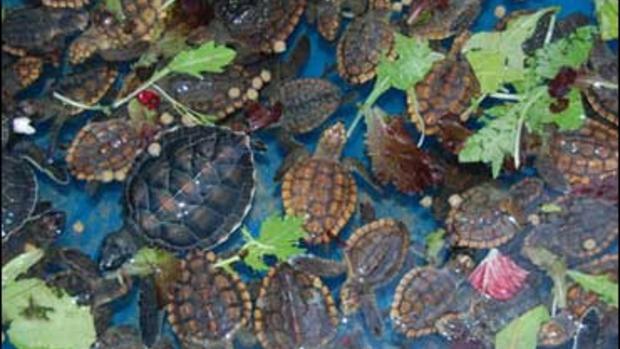Sea turtle nesting season begins, but hatching obstacles remain
It's that time of the year again for sea turtles: nesting season, and wildlife officials are hoping for another good turnout this year.
Nesting season officially began on Saturday, March 1. In March, leatherback sea turtles are first to lay eggs along Florida's Atlantic coast, followed by loggerheads and green sea turtles later this spring, according to CBS Miami.
More sea turtles nest in Florida than anywhere else in the United States. Florida's sea turtle nesting season typically runs through October, though it continued late into the fall last year.
Classified as an endangered species since 1982, an estimated 38,000 green sea turtle nests were laid last year, according to earlier CBS News reports. That was a dramatic increase over the average of 9,900 nests each year between 2005 and 2012.
"It's hard to even believe as a biologist, no one could have imagined it," Dr. Blair Witherington told CBS News last year.
Green sea turtles grow to weigh up to 700 pounds. They are commonly found along the shores of Europe, North and South America and are named for the color of their skin, not their shells.
Their nesting and hatching process is straightforward. Adult females choose a spot on the beach -- most likely the same one where they were born -- and dig a large hole.
They then lay between 100 and 200 eggs and upon covering them up, return to the sea. After incubating for several months, the hatchlings break through their eggs, burrow out of the sand and scurry towards the brightest light they see. This should be the moonlight over the ocean.
Animal activists and biologists, while thrilled about the successful conservation effort of these sea creatures, remain worried about their survival.
The combined glow of artificial lights -- known a skyglow -- may attract hatchlings away from the ocean, leaving thousands of hatchings "wandering around in circles... in dunes or in pools, or smashed on roadways," Witherington said. "Hatchlings use light to find the ocean. And if they don't find the ocean, they will die. They depend on a natural light field that is brighter over the ocean than it is over the land."
Non-profit organizations, such as Sea Turtle Oversight Protection (STOP), have tried to protect hatchlings from skyglow, by educating local residents about turtle-safe lighting.
The rapid growth of green sea turtle populations has also caused a rapid decrease in their food supply in Indonesia.
New research has suggested that the gentle creatures are crowding into an Indonesian marine reserve in numbers that risk depleting seagrass. Usually found munching on seagrass -- much like cows grazing in a field -- turtles are forced to claw at the plants with their flippers and rip out the seagrass with their mouths.
They are "creating sort of piles of mud in the seagrass bed where they've eaten the underlying root matter, and it can take a hell of a long time for that to come back," co-author Peter Mumby, a marine ecologist at the University of Queensland in Australia, told the Associated Press. "So essentially, they're going to eat themselves out of house and home."
Seagrass serves as part of an important ecosystem -- not only providing food, shelter and nurseries for other types of fish, mammals and invertebrates -- but maintaining the health of coral reefs, mangroves and marshes, while preventing erosion and keeping water clear by trapping sediment coming from land.
Nearly 14 percent of seagrass species are at risk of going extinct, due to factors such as pollution, coastal development, deforestation, sedimentation, sewage runoff and dredging, according to a 2011 global survey.
In spite of the rapid population growth in recent years, green sea turtles are still classified as endangered on the Red List of Threatened Species, published by the International Union for Conservation of Nature.
